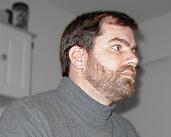
|
|
|
Welcome to Orb Designs ... This is my utterly random and significantly incompetent field trip to the Contact 2002 conference which was held at Nasa Ames Center and the Santa Clara Marriott over a 3 day span. I forgot my camera the first day, and was far to polite to take good pictures at any other time, so you'll need to bear with me here...
|
Day One was held at Nasa Ames, adjoining Moffett Federal Airfield, which has been considerably more active (and restricted) since 911. They've put up an iron fence splitting the base into low and higher security areas, which made today possible, as well as allowing the Computer History Museum and other facilities on "base" to resume semi-normal operations. I was... oh, about an hour early for things to get going, but at least I got my choice of donuts, and the coffee was fresh. Ames Say was free - not a part of the actual conference, but certainly very related and coordinated.
As I noted above, I didn't take my camera on the first day, despite having gotten out the spare batteries and thought about it at least three separate times. Sigh. The theme for the day was Is The Universe Rife With Life? The morning started with one of the grand old men of Astrobiology, Bill Blumberg, talking about how to recognize life. He was followed Penny Boston talking about slime mats and snot ropes (underground terran life forms, cavedwellers) and Chris Chyba on the topic of life around Giant Planets.
The afternoon session was cool. Moderated by Seth Shostak, we heard from Bill Borucki, then Frank Drake (which was WAY cool), followed by Bob Zubrin, on his Panspermia horse, as usual. Then we had a point-counterpoint from Al Harrison and Jim Funaro on the social implications of not finding or finding non-terrestrial life. Wandering out after session, I stopped in to have a look at the artwork of Roger Arno.
In the evening, we were treated to a not-too-shabby banquet dinner. Well, treated isn't the correct word - it was an extra money event, but worth it since we had a keynote by Rusty Schweickart. Rusty spoke on the topic of how to plan for and combat asteroid and cometary probable impacts, then lead into unstoppable ELE, and thus into his conception of Legacy. That's some ill-defined form of genetic diaspora that has been theoretically designed to survive things like close supernova, gamma ray bursters and the like. Mmmm. Then he suggested that we were the result of such a Legacy act, and we ought to be looking for messages in our own genetic code. Jerry chipped in at one point and suggested that the projects computer power be found in all the machines currently running Seti@Home. I didn't know Jerry didn't like that... Interesting evening, by any account.
Day Two was the beginning of the conference proper. The morning Plenary session was on the topic of education for the future. People are using the materials of Seti and Mars colony mockups and virtual contact and off-Earth agriculture and habitats to involve and motivate both kids and adult learners to improve the frighteningly pathetic state of science education and scientific awareness in the United States. For example, one guy uses world-building to teach concepts of Astronomy, Ecology, Environment and Biology to college level students. His biggest roadblock? One word: God.
I'm going to leave my response to a couple simple sentences: I have no problem with your faith, or with mine. But when faith and reality conflict, I worry that incorrect decisions can be made from the resulting disconnect. Ah, well. We humans are funny beasts, aren't we? Here's some pictures from the day:

VLearn, from the UCSC Virtual College project |

More from the VLearn |

Botball slide |

David Miller, progenitor of Botball. |
It's very cool - Botball (explicitly not "battlebots") are programming/engineering competitions/teaching tools using Lego, Mindstorms and extensions thereto to teach kids. One teacher at Foothill High, over on the east side of San Jose has seen that continuation schools college enrollment climb dramatically. They used to have about 30% of their students continue into Junior Colleges. Now they have about that number going to UC, and virtually all the rest start off at a JC now. The efforts required apparently awaken a joy in learning that's unbeatable. And the teachers are noticably enthusiastic about their success.

Gus Frederick, looking at ET Agriculture and more |

Mouse life support condo from Gus |

Botball action |

SolSys Senario Tweaking |
In the last formal presentation of the morning, Gus Frederick is doing some really interesting efforts in both Extra Terrestrial agriculture, and in life supports systems, at least on a small (mouse sized) scale. After a short break, all of the projects and efforts presented in the first plenary were displayed and/or discussed in greater detail in several rooms nearby. Meantime, SolSys, a Mars colonization simulation scenario, is critiqued in a panel format with some famous guests. In the rightmost picture above, we have Vernor Vinge at the left, and Rusty Schweickart second from the right. Below left is the one glam shot I got the whole weekend, Rusty in thought...

Rusty Schweickart at the SolSys scenario tweaking session. |

Bruce Damer of the Contact Consortium |

Image from a recent virtual conference - Avatars galore! |

COTI Mid-session presentations |
Bruce Damer made a presentation for the Contact Consortium (sort of a spinoff, somehow, in a way I don't understand) - you can find out more about them at http://www.ccon.org/. Since real conventions are so expensive to mount, they now have virtual conferences. Looks kinda fun, eh? And you don't have to be frisked by an underpaid and surly, naturalized Federal employee to get there... There was also information given about the Digital Biology Project, found online at http://www.biota.org/
In the afternoon, we had another Plenary session with David Moore on the topic of possibilities for the bounds of the Drake Equation (N == L), Doug Raybeck on Contact possibilities, and the congenial Seth Shostak on When The Heck Will Seti Succeed? The answer to that last question is, funding and species survival questions aside, no later than 2050. It turns out that Moore's Law applies very nicely to radio astronomy. In my probable lifetime, we will have examined that portion of the radio spectrum in the so-called Water Hole (between the Hydrogen and Hydroxyl lines) for every star in the Milky Way. Then we'll know... that they're not talking in radio, in that portion of the spectrum, at some point in time over the last 10 to 80,000 years or so. That is, we won't know much, unless the effort succeeds. Now that, that I want to see.
The afternoon wrapped up with presentations by the two COTI teams. These are high school students from Oroville who are building worlds, ecologies, animals and then evolving them. The big competion is on Sunday afternoon, when the kids put their worlds and species in contact, and run a sim on the possible results. Two days to build a world? Wow! These are some very bright kids.

Israel Zuckerman, COTI coordinator. |

COTI presentations |

COTI presentations |

COTI presentations |
After a couple of hours break (I came home for dinner, stir fry yum), we resumed for a special evening session in tribute to Poul Anderson. Speaking were Jim Funaro, Joel Hagen, Karen Anderson, Larry Niven, Jerry Pournelle and Vernor Vinge. Apparently Marvin Minsky wasn't able to make it. Following the "official" tributes, the mic passed from hand to hand as people related their direct and indirect experiences with Poul. It was a marvelous evening, and I chose not to take any pictures there - others did, and they may turn up some time. I just didn't want to flash people, and it was too dim for no-flash photography. I left shortly thereafter, although I did have a nice patch of conversation or two with Roland Dobbins, Jerry Pournelle and Larry Niven. (I neglected to mention that I got the latter two of that trio to hancock my hardbound copy of The Burning City, on the very first day of the conference)

Michelle Merrill on Apes and Language. |

PPT on Chimps and cultural, social behaviour. |
On Sunday, we had a few presentations in the morning. I was up bright and early, there and ready for the sessions to start at 0900. Mmmm. Awfully quiet around here... A quick check of the schedule showed me that I was 1.5 hours early. Sigh. I could have used sleeping in without the alarm, eh? Above you can see Michelle Merrill, and a slide from her presentation on communication, language and ape intelligence. The association is that we need to figure out how intelligent behaviour evolves, and we only have the one dubious example of ourselves to go on right now. Then we had Lara Battles talk about Linguistic Morphology Fields (I think), and finally Charles Ostman spoke way too quickly about far too many topics involving evolution, digital-biological convergance and quantum foam... I think Charles needs a three day conference of his own - It was almost like a readers digest condensed version of a season's worth of James Burke connection episodes, boiled down to a twenty five minute talk. Whew!
Now I have to admit that I skipped the final session of the conference. The kids were going to present their final efforts and run the contact scenario, but I came home and did a weekend's ration of chores, inside and out, in about 4 hours. Now I'm tired and sore, so I'm going to bed. I enjoyed myself tremendously at Contact 2002, I'll be going next year if I can swing it. I learned a lot, and I hope you enjoyed this Brian's Eye view of the proceedings. Hasta!
Pictures and text Copyright © 1999-2002 Brian P. Bilbrey. Images of content that may be held by other rights holders might be represented in these pictures. If so, please drop me a line and I'll pull the picture and put your email up in it's place. OK?




















